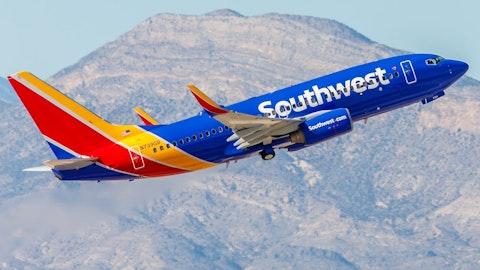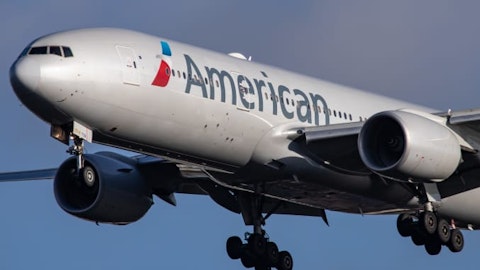Vasu Raja: Absolutely. I would be happy to do that. Look, first of all, in our revenue forecast, we don’t assume any change to some of the fundamentals of airline demand. We presume that airline industry revenues will regain its historical relationship with GDP, roughly about a point of percent. We also presume the same historical relationship between revenue and fuel prices. But what is very important is that as we’ve talked about for some time, what’s different about us is that we have used the last few years to really materially change our network, our partnerships and our fleet and that really bleeds through in our forecast for next year. If you compare our capacity mix just in future schedules that we have published to what we did in 2019.
We’ve taken 5 points of capacity out of our lowest RASM, lowest-margin long-haul flights, and we’ve grown 5 points of capacity in our highest-margin short-haul flights. Additionally, within the short-haul system, we’ve taken 5 points of capacity from some of our lowest performing, lowest RASM market and redeployed it into our Sunbelt hub, which are not just our highest RASM market, but some of the highest rosin markets in the industry. So when you think about that, that’s 10 points of capacity mix that we’ve taken from truly the lowest RASM, lowest margin things and put into some of the highest margin things that that are out there. And you’re seeing some of that trend already through ’20. So that was a thing that have been in our past schedules.
You see it in our quarter one schedules, and that drives a lot of our revenue performance. Now to put that into a bit of focus, 10 points of capacity in an airline of our size. You can think of that as larger than just about any airline hub with the exception of DFW, Charlotte and maybe one or two other hubs that our competitors operate. So that is a material reworking of our airline network over the last few years. But what’s just as important is how we have done it, which is really to a significant amount of fleet simplification. So we — over the last few years, we’ve shed 50 long-haul capable airplanes, many of which were really inefficient, like the 757 to 767. We’ve up-gauged both the regional jet and the main lines that we’ve got. And we’ve simplified the airline down to four fleet types.
So what that enables us to do is in the fleet that’s left, we can much more dynamically alter schedules to follow where the demand is. But we can produce schedules that, as you heard David and Robert talk about, are a lot more operable and frankly, a lot more efficient. So we’ve seen the benefits of that in our recent revenue performance, and we anticipate the benefits of that in the year ahead.
Operator: Our next question comes from the line of Jamie Baker of JPMorgan.
Jamie Baker : First, Derek, what a run you’ve had, just wanted to wish you the very best from the JPMorgan team as you transition. I still remember hanging up on you on October 24, 2003. Apologies again for that. Hopefully, it’s
Derek Kerr : Thanks, Jamie.
Jamie Baker : A question for Vasu. So Southwest cited passenger cancellations didn’t book away as part of its first quarter guide this morning. I’m wondering what the benefit for American in Dallas and Chicago might look like? And whether you see share tapering back to pre-December levels in March? Or do you think there’s possibly a longer tail to any Southwest benefit that you might be picking up? After all, I mean you’re on time and — excuse me, you’re on time and completion factors obviously speak for themselves over the holidays.
Vasu Raja: Yes. Hey, Jamie, thanks for the question. Look, we don’t see any recognizable benefit from what other airlines are doing. For us, it really is as simple as when we go put the flights in places people want to go and operate it well. The bookings come the revenue materializes. And there’s really not a lot of facts that we can point to beyond that very simple truth.
Jamie Baker : Okay. Fair enough. And a follow-up, Doug wasn’t shy in discussing hub profitability, L.A., Miami and JFK being the real drags on margin, D.C., Charlotte, Dallas, the obvious standouts. And L.A. has obviously seen some rationalization. You have NEA contribution up here in my neck of the woods. I’m just wondering whether your internal model shows the range between your most and least profitable hubs narrowing? And if so, what the specific drivers might be?
Vasu Raja: Yes. So the short story is we do see an improvement in very many of our hubs as we’ve gone and restructured the network. And in some cases, like look, as you think about partnerships for us, we don’t see those very differently from how we think about our own airline network. But when you put a codeshare flight number or an American Airlines operated flight number, it has the same effect of creating more network for customers, and there’s a real benefit for it. But as much as anything — there’s two things going on. One, demographically, we see so much growth in the interior of the country. And two, what is really driving our hub profitability is for a great number of cities American Airlines has the best network for so many customers.
There’s 300 cities that we serve today. In 2019, we served roughly the same amount of cities. Most of our competitors have actually shrunk the number of cities that we’ve served. But furthermore, within the city that we have in about 200 of those 300 cities, we have a material schedule advantage to other airlines that operate there. So that creates an effect that is actually really beneficial across all of the hubs in our network, and indeed, some of how we see hub profitability and how these hubs work together has changed materially through the pandemic. And to my earlier comment, that’s why we’ve restructured so much of the airline network as we have.
Vasu Raja: Jamie, you mentioned Los Angeles. So I’d like to pass you to expand on that a little bit. Look, in Los Angeles, we’re within a limited amount of gates. And let’s face it, we need to use those. We need to use those in a way that’s profitable. We’ve taken a look at that. But we can tell you the kind of changes we make. Well, yes, look, in L.A. much like in New York, through our partnerships, we’ve been able to create something really cool for customers where — if you think about it in the times past, we flew 50 seaters and small RJs in markets where we didn’t really have a scheduled proposition for customers. And in both of those markets, take it L.A. and New York. Effectively, what we’ve done is we’ve turned 50 seaters, which are not particularly efficient and long haulers.
777s that are flying a whole lot further. So we’ve up-gauged in both of those markets materially. We’ve been able to use partnerships to go and offer a much broader network for customers. And now we’re in this place where lo and behold, we’re adding a third LA Heathrow because it’s really — to Robert’s point, a very efficient way to go use gates and leverage what we’ve got with customers. In New York, so much of our growth is actually powered by long-haul flights that are flying within the partnerships that we have with Qatar, British Airways. And the net effect of that has been really positive outside of really good financial results, which we see in our revenue trends. For the first time ever, our top 2 markets for AAdvantage enrollments are New York and Los Angeles.
We’re signing up more credit cards there. We are originating — we’re having growing originating market share in those places. So a lot of what we’ve done is, frankly, up-gauge in those markets. We’ve gotten a lot smarter about what we do for customers. Yet at the same time, there are partnerships we can offer them so much more.
Jamie Baker : I’ll sound like a broken record, but thank you yet again for such a thorough response.
Operator: Our next question comes from the line of Scott Group of Wolfe Research.
Scott Group : So if I just look at the first quarter TRASM guide versus Q4 implies a much sort of bigger drop than normal sequentially Q4 to Q1. And just any thoughts, color there? And then I want to kind of ask that in the context of fuel. So spots obviously a lot higher than what you’re guiding to. What’s your confidence that you can recapture fuel with higher TRASM than you’re already guiding to for the year?
Vasu Raja: Yes. Scott, this is Vasu. I’ll start. I think Devon we’ll finish this one out. Look, First and foremost, as we’re starting this year, we have been really encouraged by demand trends. Historically, the first three weeks coming out of the holiday season are our strongest sales weeks these first three weeks have been the strongest that we’ve seen in the post-merger airline. And we’re really encouraged by that. And you see that, of course, in our TRASM guide out there. Now what is interesting though is as we are building first quarter, what is different from times past is we have been very conscious in Q1 about how we use the airlines resources. It’s people, it’s planes, it’s facilities, everything, largely so that we can have as much of that capacity for the summer peak as possible.





